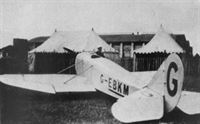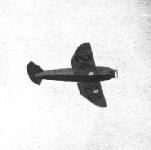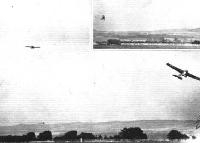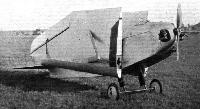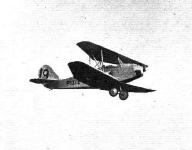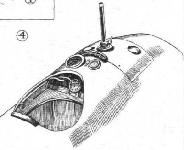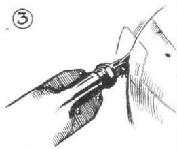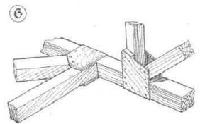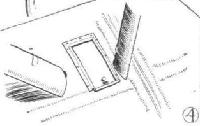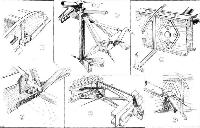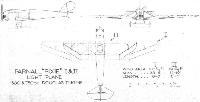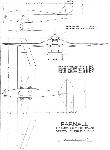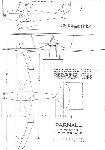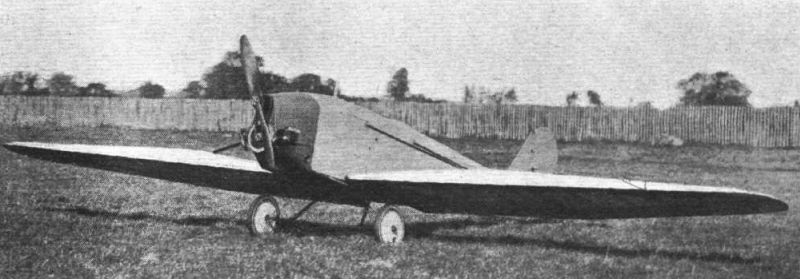
Parnall. Самолеты
<...>
В том же году (1923) Болас сконструировал одноместный деревянный сверхлегкий моноплан Pixie для участия в конкурсе легких самолетов в Лимпне. Самолет был оснащен двигателем Douglas объемом 500 см3, но затем на нем был установлен такой же двигатель объемом 736 см3. Самолет выиграл приз за скорость, развив 122,5 км/ч, после чего Министерство авиации заказало два самолета Pixie с двигателями Blackburne Tomtit объемом 696 см3. Позже они стали гражданскими самолетами.
Два последующих самолета Pixie были построены для соревнований 1924 года и конструктивно являлись двухместными бипланами со съемным верхним крылом. Один имел двигатель Bristol Cherub III мощностью 32 л.с„ а другой - Blackburne Thrush мощностью 35 л. с. На последнем самолете был установлен впоследствии двигатель Anzani объемом 1100 см3. Обе машины были переделаны в монопланы в 1926 году и получили двигатели Cherub III. Один из самолетов частично сохранился и находится в Мидлендсе.
<...>
Описание:
- Parnall. Самолеты
- Flight, October 1923
THE PARNALL "PIXIE" LIGHT 'PLANE - Flight, September 1924
THE PARNALL "PIXIE III" LIGHT MONOPLANE (No. 17) - Flight, September 1926
British Light ‘Plane Development & Lympne Meeting
Фотографии
-
Flight 1923-10 / Flight
THE PARNALL "PIXIE I": Three-quarter front view.
-
Flight 1923-10 / Flight
THE PARNALL "PIXIE I": View of the engine mounting, transmission and under carriage. The latter is of unusual type, consisting of two sloping struts carrying the axle. There is no springing beyond that provided by the flexibility of the steel tubes.
-
Flight 1923-10 / Flight
THE PARNALL "PIXIE I": Three-quarter rear view. Standing by the machine are Capt. Macmillan, the pilot, and Mr. Bolas, chief engineer and designer of the Parnall machines.
-
Aeroplane Monthly 1980-10 / K.Wixey - Parnall Pixie /British pre-war ultralights/
LIGHT 'PLANES AT HENDON: A general view of the "Paddock"; in the foreground the Parnall "Pixie II" speed 'bus.
Parnall Pixie II, with 18ft wings, seen at Hendon on October 27, 1923, where, piloted by Capt Norman Macmillan, it won the Wakefield Prize with a speed of 81 m.p.h. -
Flight 1923-10 / Flight
76.1 m.p.h.: The Parnall "Pixie II," on which Capt. Macmillan won the Abdulla speed prize of ?500 at Lympne. A photograph of "Pixie I," which has larger wings and a smaller engine, was published last week.
-
Aeroplane Monthly 1980-10 / K.Wixey - Parnall Pixie /British pre-war ultralights/
Parnall Pixie II in original form, with 29ft wings absent, at Lympne a few days earlier.
-
Flight 1923-10 / Flight
No. 9, the Parnall "Pixie I," at Lympne, being wheeled through a gate in the transport test. On the right, Capt. Macmillan, "Pixie's" pilot. Inset, the machine coming in to land.
-
Flight 1924-10 / Flight
THE LIGHT 'PLANE RACE FOR THE GROSVENOR CHALLENGE CUP: 3 shows the machines lined up for the race
-
Aeroplane Monthly 1980-10 / K.Wixey - Parnall Pixie /British pre-war ultralights/
Регистрационный номер: J7323 THE LIGHTER SIDE OF THE R.A.F. PAGEANT: Two light 'planes, which led in the "Fly Past": the Parnall "Pixie" and the D.H.53, both fitted with Blackburne "Tomtit" engines.
Parnall Pixie II J7323 at the 1924 RAF Hendon Air Pageant, re-engined with a 698cc Blackburne Tomtit engine.Другие самолёты на фотографии: De Havilland Humming Bird / D.H.53 - Великобритания - 1923
-
Aeroplane Monthly 1991-11 / Personal album. Civil
Регистрационный номер: G-EBKM [6], J7324 [6] Following ten years' storage after competing in the 1925 Lympne trials, Parnall Pixie II G-EBKM was sold to F. J. Cleare at May lands in April 1936, and it is seen there in August 1937. It was sold to Ray Bullock in August the following year, and crashed in April 1939.
-
Aeroplane Monthly 1980-10 / K.Wixey - Parnall Pixie /British pre-war ultralights/
Регистрационный номер: G-EBKM [6], J7324 [6] Parnall Pixie I G-EBKM, ex J7324, seen at Maylands aerodrome, Romford, on April 4, 1937, about to be flagged off at the start of a race.
-
Aeroplane Monthly 1978-02 / Personal album
Регистрационный номер: G-EBKM [6], J7324 [6] Parnall Pixie I G-EBKM was a single-seater built for the 1923 Lympne Light Aeroplane Trials. It was designed with two sets of interchangeable wings and engines, and is seen here with short, 18ft span wings and the 736cc Douglas engine, in which form it was known as the Pixie II.
-
Aeroplane Monthly 1978-02 / Personal album
Регистрационный номер: G-EBKM [6], J7324 [6] -
Aeroplane Monthly 1980-06 / Maylands /Gone but not forgotten/ (8)
Регистрационный номер: G-EBKM [6], J7324 [6] F. J. Cleare’s Parnall Pixie G-EBKM in August 1937.
-
Aeroplane Monthly 1982-07 / P.Capon - Capon's Corner
Регистрационный номер: G-EBKM [6], J7324 [6] The Parnall Pixie was designed by Harold Bolas for the 1923 Lympne Trials. In 1924 the Air Ministry ordered two military examples for comparative tests with the ANEC 1, Avro 560 and a D.H.53. One, J7324, subsequently appeared on the British civil register as G-EBKM and was initially owned by Parnalls. P. T. Capon photographed this aircraft at Stag Lane in September 1925. Standing by the Pixie is R. E. Bishop, then a D.H. apprentice (the very first), who later became de Havilland's chief designer.
-
Flight 1925-08 / Flight
LOW-WING MONOPLANE: Courtney making a vertical bank on the " Pixie II."
-
Flight 1923-11 / Flight
WINNING LIGHT 'PLANES AT HENDON: Capt. N. Macmillan on Parnall "Pixie II," winner of the Speed Contest.
-
Flight 1923-11 / Flight
LIGHT 'PLANES AT HENDON: "Jimmy" James banking - and leading - in the third heat of the Handicap Race. Close behind are F.P.Raynham (left) on the Handasyde and (right) Capt. Macmillan on Parnall "Pixie II."
Другие самолёты на фотографии: ANEC I / II - Великобритания - 1923Handasyde monoplane - Великобритания - 1923
-
Aeroplane Monthly 1980-10 / K.Wixey - Parnall Pixie /British pre-war ultralights/
THE PARNALL "PIXIE III," BRISTOL "CHERUB" ENGINE: Three-quarter rear view. This machine can be converted into a biplane.
Pixie III of 1924 fitted with a 32 h.p. Bristol Cherub III flat-twin air-cooled engine. -
Aeroplane Monthly 1980-10 / K.Wixey - Parnall Pixie /British pre-war ultralights/
Регистрационный номер: G-EBJG [4] Representative type of the pre-1926 "ultra-light" era: Parnall Pixie (36 h.p. Bristol Cherub flat twin) as a monoplane
Parnall Pixie III G-EBJG in monoplane form, powered by a 32 h.p. Bristol Cherub III engine, at the 1924 Lympne Trials. -
Aeroplane Monthly 1980-10 / K.Wixey - Parnall Pixie /British pre-war ultralights/
Регистрационный номер: G-EBJG [4] Parnall Pixie III G-EBJG complete with registration and unfaired forward cockpit.
-
Flight 1924-11 / Flight
Регистрационный номер: G-EBJG [4] THE PARNALL "PIXIE III" LIGHT 'PLANE: This photograph shows the machine in monoplane form, but it will be recollected that it can be converted into a biplane, and that, as a matter of fact, it flew in this guise at Lympne. The machine shown is that carrying the number 18 in the competitions. Mr. Frank Courtney is in the pilot's seat, and Mr. Harold Bolas is the passenger on this occasion.
-
Aeroplane Monthly 1980-10 / K.Wixey - Parnall Pixie /British pre-war ultralights/
Регистрационный номер: G-EBKK [7] Parnall Pixie IIIA G-EBKK in monoplane form. The original 35 h.p. Blackburne Thrush engine was later exchanged for a 1,000 c.c. Anzani.
-
Flight 1925-08 / Flight
Регистрационный номер: G-EBKK [7] LINING UP FOR THE LIGHT 'PLANE HOLIDAY HANDICAP: the line-up for the second heat.
-
Flight 1926-09 / Flight
READY FOR BRIGHTON: Some of the machines lined up ready for the start on the first circuit on Sunday morning. On the right, the Bristol "Brownie," which was the first machine away. The other machines are the Parnall "Pixie," the Avro "Avis," and the de Havilland "Moth."
Другие самолёты на фотографии: Avro Avis / Type 562 - Великобритания - 1924Bristol Brownie / Type 91 - Великобритания - 1924De Havilland Moth / D.H.60 - Великобритания - 1925
-
Flight 1926-09 / Flight
LINE UP FOR THE S.M.M.T. RACE: From left to right the machines are: de Havilland "Moth," Avro "Avian," Farnborough "Cygnet," Parnall "Pixie," and Bristol "Brownie." This race was won by Hinkler on the Avro "Avian," at an average speed of 90 m.p.h.
Другие самолёты на фотографии: Avro Avian / Type 594/616 - Великобритания - 1926Bristol Brownie / Type 91 - Великобритания - 1924De Havilland Genet Moth - Великобритания - 1926Hawker Cygnet - Великобритания - 1924
-
Flight 1926-12 / Flight
Parnall Types - From left to right: The Plover seaplane, Pixie, Possum triplane, and Plover ship fighter.
Другие самолёты на фотографии: Parnall Plover - Великобритания - 1922Parnall Possum - Великобритания - 1923
-
Flight 1924-10 / Flight
THE LIGHT 'PLANE RACE FOR THE GROSVENOR CHALLENGE CUP: 4 shows Douglas on the Parnall " Pixie IIIa";
-
Flight 1926-09 / Flight
THE RACE FOR THE GROSVENOR CHALLENGE CUP: No less than 21 machines faced the starter for this race, a record number. The result was that machines frequently got bunched together at the turning points. Our photograph show one of some such incidents. In 3 may be recognised the Short "Satellite," the Parnall "Pixie" and the R.A.E. "Hurricane."
Другие самолёты на фотографии: RAE Hurricane - Великобритания - 1923Short Satellite / S.4 - Великобритания - 1924
-
Flight 1926-09 / Flight
ELIMINATING TRIALS AT LYMPNE: 3, Courtney on the Parnall "Pixie III," is well above the flags.
-
Flight 1924-09 / Flight
The Parnall "Pixie" two-seater light 'plane has a forced landing. On a recent flight the machine came down at Henbury owing to plug trouble. It had its wings folded, was pushed through four gateways to a larger field, from which it took off quite easily, and returned safely to the Filton Aerodrome.
-
Flight 1924-09 / Flight
The Parnall "Pixie III," with wings folded for transport. Note the neat cowling around the Bristol "Cherub" engine. The cantilever undercarriage should be observed.
-
Flight 1926-09 / Flight
THE FIRST OF THE ELIMINATING TESTS AT LYMPNE: Some of the competing machines photographed during the folding, housing and re-erecting test. 4, the Parnall "Pixie III"
-
Flight 1925-08 / Flight
GOODBYE LYMPNE: The Parnall "Pixie III," waiting for the Southern Railway.
-
Flight 1926-09 / Flight
THE PARNALL TEAM: Left to right, J. Smith, J. W. Copley, H. Bolas (designer), F. Courtney (pilot), T. Healey, W. Lane, and D. Twose.
-
Flight 1924-10 / Flight
Регистрационный номер: G-EBJG [4] Pixie IIIA in biplane configuration and flown in 1924 at Lympne. In the official races it was flown in monoplane form still as No.18. This machine is fitted with a Bristol "Cherub."
Pixie IIIA G-EBJG, flown at the 1924 Lympne Trials by Flt Lt R. A. de Haga Haig. Aircraft retired with engine trouble. -
Flight 1924-10 / Flight
Регистрационный номер: G-EBKK [7] TAKE-OFF AND PULL-UP TESTS AT LYMPNE: 1, Wheeling Longton's Hawker "Cygnet I" and Douglas's Parnall "Pixie IIIa " back for the take-off tests.
Другие самолёты на фотографии: Hawker Cygnet - Великобритания - 1924
-
Aeroplane Monthly 1980-10 / K.Wixey - Parnall Pixie /British pre-war ultralights/
Регистрационный номер: G-EBKK [7] TAKE-OFF AND PULL-UP TESTS AT LYMPNE: 5, The Parnall "Pixie IIIa" in the pull-up test.
Representative type of the pre-1926 "ultra-light" era: Parnall Pixie (36 h.p. Bristol Cherub flat twin) as a biplane
The Parnall Pixie IIIA, G-EBKK, competing at the 1924 Lympne Trials. Aircraft retired with engine trouble. -
Flight 1924-10 / Flight
Регистрационный номер: G-EBKK [7] The Second Parnall "Pixie III" mono-biplane, No. 19, in flight.
-
Aeroplane Monthly 1980-10 / K.Wixey - Parnall Pixie /British pre-war ultralights/
Регистрационный номер: G-EBKK [7] TAKE-OFF AND PULL-UP TESTS AT LYMPNE: 2, The Parnall "Pixie IIIa" clearing the 25-ft. posts.
Parnall Pixie IIIA G-EBKK, flown as No 19 by Wg Cdr W. F. Sholto Douglas, competing in the 1924 Lympne Trials. -
Aeroplane Monthly 1980-10 / K.Wixey - Parnall Pixie /British pre-war ultralights/
Регистрационный номер: G-EBKK [7] LOW-SPEED FLYING AT LYMPNE: 6, Douglas on the Parnall "Pixie."
-
Flight 1923-10 / Flight
LIGHT 'PLANES AT LYMPNE: Some interesting constructional features: 4, View into the cockpit of the Parnall "Pixie." Note the petrol level indicator.
-
Flight 1924-09 / Flight
Side elevation of the Parnall two-seater light monoplane.
-
Flight 1923-10 / Flight
LIGHT 'PLANES AT LYMPNE: Some constructional details. 1. Aileron on the Parnall "Pixie"; the rear spar is swept forward to meet the front spar at the wing tip; the ailerons have a differential action.
-
Flight 1923-10 / Flight
LIGHT 'PLANES AT LYMPNE: Some constructional details. 3. The neat strut-end with adjustment on the Parnall "Pixie."
-
Flight 1924-10 / Flight
SOME MORE CONSTRUCTIONAL DETAILS FROM LYMPNE: (7) Wing bracing strut quick-release on Parnall "Pixie IIIa." The small tubular strut runs to root of lower front spar.
-
Flight 1923-10 / Flight
LIGHT 'PLANES AT LYMPNE: Some constructional details. 7. Adjustable tail fitting on Parnall "Pixie."
-
Flight 1923-10 / Flight
LIGHT 'PLANES AT LYMPNE: A few interesting constructional features. In 6 is shown the joint of struts to longerons on the Parnall "Pixie."
-
Flight 1924-10 / Flight
CONSTRUCTIONAL DETAILS OF LIGHT 'PLANES AT LYMPNE: (4) Mounting of Bristol "Cherub" in Parnall "Pixie IIIa."
-
Flight 1924-10 / Flight
SOME MORE CONSTRUCTIONAL DETAILS FROM LYMPNE: (4) Inspection door and steel attachments on lower starboard wing of Parnall "Pixie IIIa."
-
Flight 1925-08 / Flight
"STOP THAT LEAK": Different methods of closing the gap between rear spar and aileron in some of the Lympne machines. 1. In the Beardmore "Wee Bee" an aluminium strip is used with edges turned over for stiffening purposes. The front edge is covered by fabric strip doped on. 2. In the A.N.E.C, an aluminum strip is used, stiffened by fore-and-aft corrugations, while in 3, the Parnall "Pixie II" three-ply is employed, and in 4, the Cranwell monoplane, rubber strip. This was later removed as it tended to cause the controls to work stiffly.
Другие самолёты на фотографии: ANEC I / II - Великобритания - 1923Beardmore W.B.XXIV Wee Bee - Великобритания - 1924Comper Cranwell III / CLA.3 - Великобритания - 1925
-
Flight 1924-09 / Flight
SOME CONSTRUCTIONAL DETAILS OF THE PARNALL TWO-SEATER LIGHT MONOPLANE: 1. A wing root, showing trunnion for attachment to fuselage. 2. The wing in place, showing attachment. 3. Lay shaft and cranks of the elevator. The tail plane tube has been omitted for the sake of clearness, as has also the tail skid, which is made from cane. 4. Details of the differential aileron control. The two cables run to the controls in the cockpit. 5. Shows the spar construction. 6. The lift tubes are attached not direct to the spar, but to the tubular compression strut of the drag bracing, so that the angularity of the lift strut does not produce twist in the spar.
-
Flight 1923-10 / Flight
Parnall "Pixie" I & II Light 'Plane 500 & 750 c.c. Douglas Engine
-
Flight 1924-09 / Flight
Parnall 2-seater Light Monoplane Bristol Cherub Engine
-
Flight 1924-09 / Flight
Parnall 2-seater Light Biplane
- Фотографии











